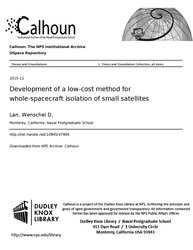File:Development of a low-cost method for whole-spacecraft isolation of small satellites (IA developmentoflow1094547804).pdf

Original file (1,275 × 1,650 pixels, file size: 18.99 MB, MIME type: application/pdf, 200 pages)
Captions
Captions
Summary[edit]
| Development of a low-cost method for whole-spacecraft isolation of small satellites
( |
||
|---|---|---|
| Author |
Lan, Wenschel D. |
|
| Title |
Development of a low-cost method for whole-spacecraft isolation of small satellites |
|
| Publisher |
Monterey, California: Naval Postgraduate School |
|
| Description |
Force-limited vibration testing (FLVT) is effective in reducing the low-frequency vibration test environment for CubeSats on the Naval Postgraduate School CubeSat Launcher (NPSCuL); however, the CubeSats are still subjected to high-frequency amplifications above 500 Hz from the NPSCuL structure. The excessive, high-frequency vibration has caused test failures and forces CubeSat developers to focus more on surviving environmental testing instead of developing state-of-the-art technology. Whole-spacecraft isolation systems are often used to reduce these amplifications, but they currently exist only for large spacecraft and are too expensive to adapt for small satellites. These limitations motivated the combined use of FLVT and commercial-off-the-shelf (COTS) isolators on NPSCuL as a novel, practical, and low-cost method to reduce vibration levels for small satellites. This method significantly reduces the high-frequency amplification by up to 97%; the root-mean-square acceleration (GRMS) over the entire test frequency range drops by up to 78%. These results should allow more sensitive and complex payloads to gain access to space on future NPSCuL missions and demonstrate how a worst-case environment on a small satellite can be improved. Implementing low-cost, COTS isolators on other small satellites and CubeSat launch applications could be useful as well. Subjects: Force Limited Vibration Testing; Whole Spacecraft Isolation; CubeSat; ESPA; Small Satellites |
|
| Language | English | |
| Publication date | December 2015 | |
| Current location |
IA Collections: navalpostgraduateschoollibrary; fedlink |
|
| Accession number |
developmentoflow1094547804 |
|
| Source | ||
| Permission (Reusing this file) |
This publication is a work of the U.S. Government as defined in Title 17, United States Code, Section 101. Copyright protection is not available for this work in the United States. | |
Licensing[edit]
| Public domainPublic domainfalsefalse |
This work is in the public domain in the United States because it is a work prepared by an officer or employee of the United States Government as part of that person’s official duties under the terms of Title 17, Chapter 1, Section 105 of the US Code.
Note: This only applies to original works of the Federal Government and not to the work of any individual U.S. state, territory, commonwealth, county, municipality, or any other subdivision. This template also does not apply to postage stamp designs published by the United States Postal Service since 1978. (See § 313.6(C)(1) of Compendium of U.S. Copyright Office Practices). It also does not apply to certain US coins; see The US Mint Terms of Use.
|
 | |
| This file has been identified as being free of known restrictions under copyright law, including all related and neighboring rights. | ||
https://creativecommons.org/publicdomain/mark/1.0/PDMCreative Commons Public Domain Mark 1.0falsefalse
File history
Click on a date/time to view the file as it appeared at that time.
| Date/Time | Thumbnail | Dimensions | User | Comment | |
|---|---|---|---|---|---|
| current | 09:41, 17 July 2020 |  | 1,275 × 1,650, 200 pages (18.99 MB) | Fæ (talk | contribs) | FEDLINK - United States Federal Collection developmentoflow1094547804 (User talk:Fæ/IA books#Fork8) (batch 1993-2020 #13831) |
You cannot overwrite this file.
File usage on Commons
The following page uses this file:
Metadata
This file contains additional information such as Exif metadata which may have been added by the digital camera, scanner, or software program used to create or digitize it. If the file has been modified from its original state, some details such as the timestamp may not fully reflect those of the original file. The timestamp is only as accurate as the clock in the camera, and it may be completely wrong.
| Short title | Development of a low-cost method for whole-spacecraft isolation of small satellites |
|---|---|
| Author | Lan, Wenschel D. |
| Software used | Lan, Wenschel D. |
| Conversion program | MiKTeX pdfTeX-1.40.14 |
| Encrypted | no |
| Page size | 612 x 792 pts (letter) |
| Version of PDF format | 1.4 |

